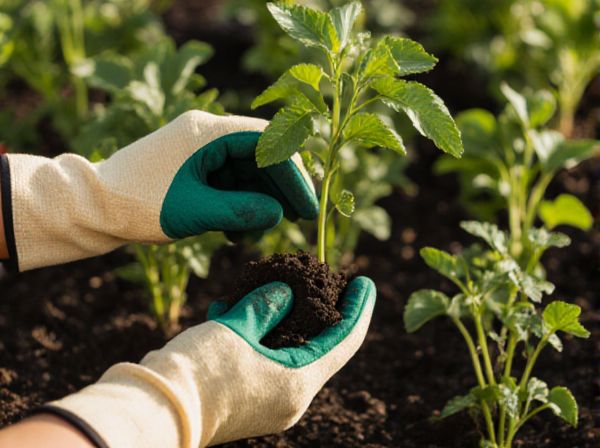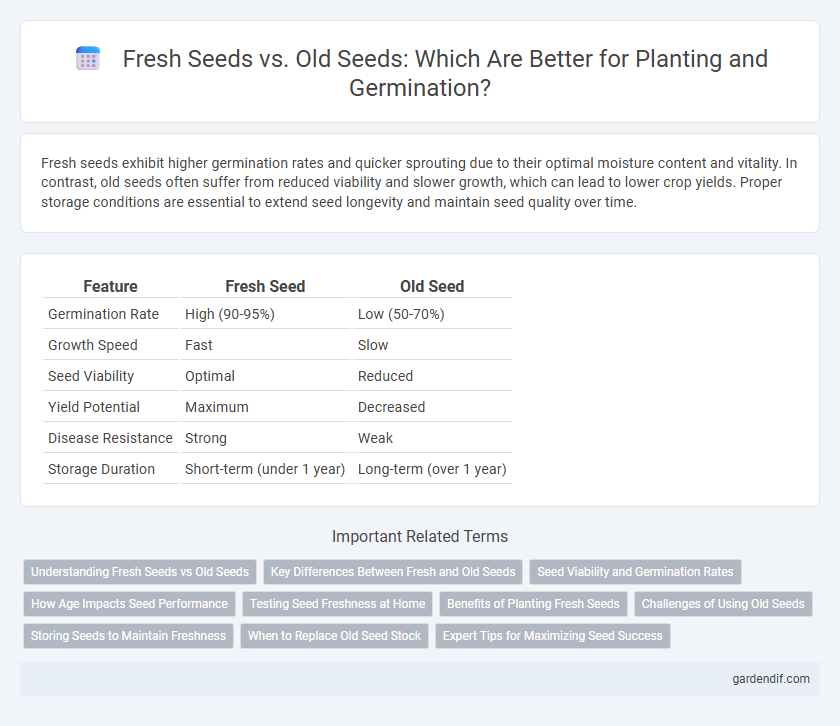
Fresh seed vs Old seed Illustration
Fresh seeds exhibit higher germination rates and quicker sprouting due to their optimal moisture content and vitality. In contrast, old seeds often suffer from reduced viability and slower growth, which can lead to lower crop yields. Proper storage conditions are essential to extend seed longevity and maintain seed quality over time.
Table of Comparison
| Feature | Fresh Seed | Old Seed |
|---|---|---|
| Germination Rate | High (90-95%) | Low (50-70%) |
| Growth Speed | Fast | Slow |
| Seed Viability | Optimal | Reduced |
| Yield Potential | Maximum | Decreased |
| Disease Resistance | Strong | Weak |
| Storage Duration | Short-term (under 1 year) | Long-term (over 1 year) |
Understanding Fresh Seeds vs Old Seeds
Fresh seeds possess higher viability and germination rates compared to old seeds, which often suffer from decreased moisture content and cellular degradation over time. Seed freshness directly impacts crop yield potential, with fresh seeds accelerating seedling emergence and vigor. Proper storage conditions, such as low humidity and cool temperatures, are crucial to preserving seed viability and extending shelf life.
Key Differences Between Fresh and Old Seeds
Fresh seeds exhibit higher germination rates and vigor due to intact viability and moisture content, while old seeds often show reduced germination caused by cellular degradation and moisture loss. Fresh seeds typically have a shorter dormancy period and better resistance to diseases compared to old seeds, which may experience increased vulnerability to pathogens and environmental stress. The physiological quality of fresh seeds ensures robust seedling growth, whereas old seeds may result in weaker plants and lower crop yields.
Seed Viability and Germination Rates
Fresh seeds exhibit higher viability and germination rates due to intact cellular structures and optimal moisture content. In contrast, old seeds often show reduced viability as aging causes degradation of enzymes and DNA, leading to lower germination percentages. Proper storage conditions can slow viability loss but cannot fully prevent the decline in germination efficiency over time.
How Age Impacts Seed Performance
Fresh seeds exhibit higher germination rates and vigor compared to old seeds, which tend to show reduced viability due to cellular degradation over time. Age negatively impacts seed performance by decreasing metabolic efficiency and increasing susceptibility to diseases and environmental stress. Proper seed storage conditions can slow deterioration, but seed age remains a critical factor in successful crop establishment.
Testing Seed Freshness at Home
Testing seed freshness at home involves a simple water germination test where seeds are placed in a glass of water for 15-20 minutes; fresh seeds typically sink while old seeds float. Another effective method is to sprout a small sample of seeds on a damp paper towel, keeping them warm and moist for several days to observe germination rates. High germination rates indicate seed vitality, whereas low rates suggest the seeds may be too old for successful planting.
Benefits of Planting Fresh Seeds
Planting fresh seeds significantly improves germination rates, resulting in quicker and more uniform seedling emergence essential for robust crop establishment. Fresh seeds maintain higher vigor and nutrient content, which enhances seedling resilience against environmental stressors such as drought and disease. Using fresh seeds ultimately leads to stronger plant growth and increased yield potential compared to older, less viable seeds.
Challenges of Using Old Seeds
Using old seeds often results in lower germination rates due to diminished viability and vigor over time, leading to inconsistent crop stands and reduced yields. Seed longevity decreases as storage conditions worsen, with factors like humidity and temperature accelerating deterioration and increasing susceptibility to diseases. Farmers relying on old seeds face challenges such as delayed germination, poor seedling growth, and higher vulnerability to pathogen attacks, all of which compromise overall crop productivity.
Storing Seeds to Maintain Freshness
Storing seeds in a cool, dry, and dark environment significantly extends their viability, preserving freshness and ensuring higher germination rates. Using airtight containers with moisture-absorbing packets prevents mold and decay, which are common problems with old seeds. Proper storage conditions maintain seed vitality, allowing fresh seeds to outperform older seeds in growth potential and yield.
When to Replace Old Seed Stock
Replacing old seed stock is crucial when germination rates drop below 80%, indicating diminished viability and reduced crop yield potential. Fresh seeds maintain higher vigor and disease resistance, ensuring robust plant development and optimal productivity. Monitoring seed age and storage conditions helps determine the precise timing for replenishing seed inventory to sustain agricultural success.
Expert Tips for Maximizing Seed Success
Fresh seeds typically have higher germination rates and vigor compared to old seeds, which often suffer from reduced viability due to prolonged storage. Experts recommend storing seeds in cool, dry environments to extend their lifespan and conducting germination tests before planting old seeds to assess their potential. Utilizing fresh seeds whenever possible ensures optimal crop uniformity and yield, while treating older seeds with pre-soaking or scarification can improve germination performance.
Fresh seed vs Old seed Infographic

 gardendif.com
gardendif.com